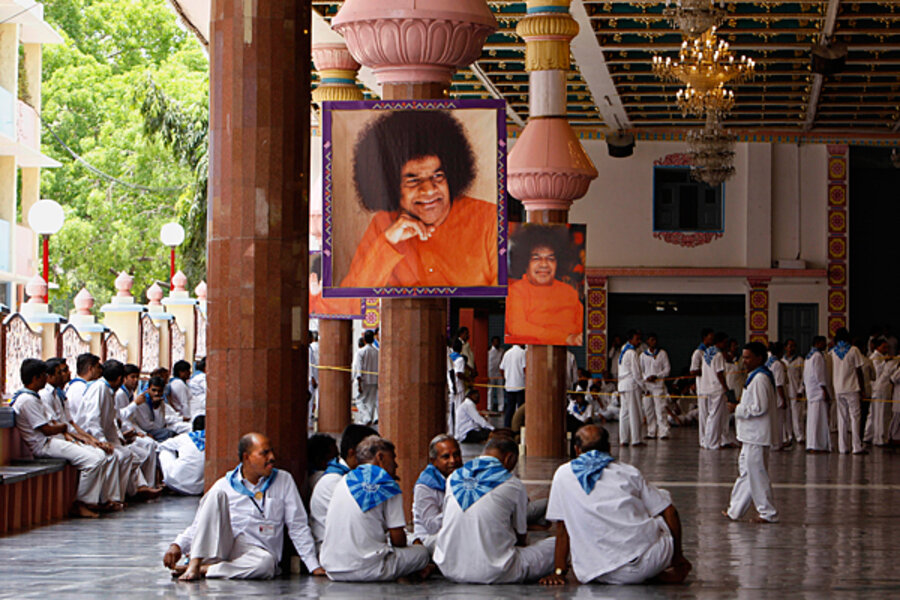Sai Baba: In modern India, traditional guru still has powerful influence
| New Delhi
Sathya Sai Baba held a venerable position in India. He was one of its best-known gurus, who are sometimes known as “godmen” here.
The informal term applies to spiritual teachers whose charisma, claims of supernatural powers, and charitable work have won them millions of devotees in an modern age of high-tech communications and rising prosperity. Indeed, the outpouring in response to Sai Baba's passing this weekend – from India’s top politicians to pop icons – reflects just how much influence the traditional guru phenomenon still holds in modern middle-class India.
“India has Hinduism – which is disorganized, no church, no text – and the godmen, who are superbly organized,” says Shiv Visvanathan, a sociologist based in Gandhinagar, India. “The best management [in India] is around religion.”
He points to an effort by Sai Baba to bring clean water to 750 villages in the state of Andhra Pradesh. In a matter of months, he says, his followers transformed Sai Baba’s wish into “a complete program of the kind neither the government nor the United Nations can pull off.”
Such feats are helped by India’s rising cadre of middle class who have organizational and technology skills – and money. Sai Baba’s organization, which funds numerous educational, medical, and social-uplift projects, is reported to be valued at $9 billion and involve millions of devotees.
That ability to mobilize and help communities gives such spiritual leaders enormous temporal sway.
“I can’t think of a bureaucrat or politician who would do anything without consulting these godmen,” says Dr. Visvanathan. “I would call them the true Fourth Estate – it’s not the media, it’s the godmen.”
Upon Sai Baba’s death, Indian Prime Minister Manmohan Singh declared him “an inspiration to people of all faiths.” And Sachin Tendulkar, the Indian cricket hero and Sai Baba devotee, went Monday to the town of Puttaparthi along with tens of thousands of mourners to pay his final respects.
While Sai Baba was raised in the Hindu tradition, he preached that “there is only one religion, the religion of love.” He claimed to be an avatar – or descent of a deity from heaven to Earth – whose mission was to make everybody see that the same God resides in everyone.
“As you get deeper into the teachings, it becomes very close to quantum mechanics – that there is a oneness. That God is one, that he is omnipresent, and we are all part of that. And it’s our duty to recognize that we are all brother and sisters,” says Samuel Sandweiss, an American psychiatrist and Sai Baba devotee.
Large followings, large ambitions
Such religious syncretism is familiar to the Hindu tradition, as are the ideas of avatars and gurus. What’s newer are the sheer size of the followings of the modern godmen and the ambition of the good works done in their name, says Visvanathan.
Dr. Sandweiss shies from classifying Sai Baba a godman. “For the devotee, he’s not a flashy person trying to get a lot of devotees and showing off supernatural powers,” he says.
That said, Sandweiss has written about numerous Sai Baba miracles in his book “Sai Baba: The Holy Man and the Psychiatrist.” Sai Baba’s devotees say he routinely could make everything from gold, ash, oil, and candies appear in his hands. These “manifestations” are often given to devotees, leading to a sense of personal relationship with the divine.
“He gave me several pieces of candy with a knowingness in his eye,” says Sandweiss, recounting a chance encounter he had with Sai Baba after feeling frustrated with his teachings. “That personal contact is at the core of the devotee’s personal relationship with him. It starts to mirror how a person feels when they have a real relationship with Jesus, Allah, or Buddha.”
For Visvanath, this type of spirituality has shown enormous appeal among the burgeoning ranks of the middle class – in India and abroad – and its insecurities.
“The middle class crisis is a search for meaning [among] ideas of mobility and success and stability,” says Visvanathan. Belief in Sai Baba as a divine figure “makes God very personal. It gives you a feeling of location in the cosmos.”
Sandweiss counters that everyone – rich, poor, or otherwise – is seeking such a connection, and that Sai Baba has many followers among all walks of life. As for the charitable work, it’s an outgrowth of spiritual – not material – progress.
The claims of Sai Baba’s miracles have also inspired fierce opposition from Indian rationalists who argue that he and other godmen are only performing magic tricks to fool people. Some critics have taken to the road, performing similar sleights of hand before villages in order to debunk them. And some also criticize Sai Baba’s organization for a lack of financial transparency.
Sai Baba passed away at age 85, some years short of his own prediction that he would live until age 96.
“As Baba has departed earlier than he had predicted, he will return to the planet earlier,” said Sri Ravi Shankar, another Indian guru with a mega-following. “Sri Sathya Sai Baba will continue to live in the hearts of millions of devotees. His message of 'Love All and Serve All' will resonate in the world forever.”





